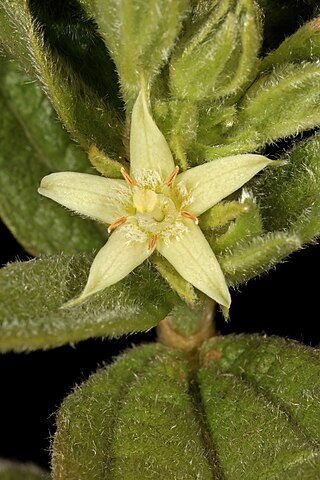
Rubiaceae is a family of flowering plants, commonly known as the coffee, madder, or bedstraw family. It consists of terrestrial trees, shrubs, lianas, or herbs that are recognizable by simple, opposite leaves with interpetiolar stipules and sympetalous actinomorphic flowers. The family contains about 13,500 species in about 620 genera, which makes it the fourth-largest angiosperm family. Rubiaceae has a cosmopolitan distribution; however, the largest species diversity is concentrated in the tropics and subtropics. Economically important genera include Coffea, the source of coffee, Cinchona, the source of the antimalarial alkaloid quinine, ornamental cultivars, and historically some dye plants.

Genipa is a genus of trees in the family Rubiaceae. This genus is native to the American tropical forests.

Galium is a large genus of annual and perennial herbaceous plants in the family Rubiaceae, occurring in the temperate zones of both the Northern and Southern Hemispheres. Some species are informally known as bedstraw.

Canthium is a genus of flowering plants in the family Rubiaceae. They are shrubs and small trees. The leaves are deciduous and the stems are usually thorny.
Hymenocoleus is a genus of flowering plants in the family Rubiaceae and occurs in tropical Africa.
Sericanthe is a genus of flowering plants in the family Rubiaceae. It is found in tropical and subtropical Africa. The genus was described by Elmar Robbrecht in 1978 based on the species in Neorosea, except for the type species, Neorosea jasminiflora, which went to Tricalysia. Bacterial leaf nodules are found in most of the species and the endophytic bacteria have been identified as Burkholderia.
Temnocalyx is a monotypic genus of flowering plants in the family Rubiaceae. It was originally described by Walter Robyns in 1928 and contained five species. Since then most of these species have been made synonym and currently only one species name remains valid, i.e. Temnocalyx nodulosa. The species is endemic to southwestern Tanzania.
Trichostachys interrupta is a species of plant in the family Rubiaceae. It is found in Cameroon and Nigeria. Its natural habitat is subtropical or tropical moist lowland forests. It is threatened by habitat loss.
Vangueriopsis is a genus of flowering plants in the family Rubiaceae.

Vanguerieae is a tribe of flowering plants in the family Rubiaceae and contains about 655 species in 30 genera. It is one of the most species-rich groups within the family and it is distributed across the Paleotropics.
Hutchinsonia is a genus of flowering plants in the family Rubiaceae. It was described by Walter Robyns in 1928 and was named after his friend and colleague John Hutchinson. It is found in west tropical Africa.

Eriosemopsis is a monotypic genus of flowering plants in the family Rubiaceae. It was described by Walter Robyns in 1928 and no changes have been made since then. The genus contains only one species, viz. Eriosemopsis subanisophylla, which is native to southeastern Eastern Cape and southern KwaZulu-Natal provinces of South Africa. The species is morphologically similar to the species Pygmaeothamnus zeyheri but differs by having a thick indumentum, raised venation and elliptical leaves.

Canthium armatum is a species of flowering plants in the family Rubiaceae. It is a shrub or tree native to southern Mozambique, Eswatini, and KwaZulu-Natal and the Northern Provinces of northeastern South Africa. The species is characterized by the presence of large spines.
Pygmaeothamnus is a monotypic genus of flowering plants in the family Rubiaceae. It was described by Walter Robyns in 1928 and originally held four species. It is found in central and southern Africa.
Fadogiella is a small genus of flowering plants in the family Rubiaceae. It was described by Walter Robyns in 1928.
Ancylanthos was a genus of flowering plants in the family Rubiaceae but is no longer recognized. It was originally described by René Louiche Desfontaines in 1818. In 2005, it was sunk into synonymy with Vangueria, based on a phylogenetic study of DNA sequences.
Argocoffeopsis is a genus of flowering plants in the family Rubiaceae. It is found in tropical Africa. They are lianas, climbing by means of horizontal or recurved lateral branches, or sometimes shrubs. Their papery bark is grey or brown and peeling off.
Virectaria is a genus of flowering plants in the family Rubiaceae. The genus, known as Virecta until 1952, consists exclusively of tropical African species. It is a Guineo-Congolian genus, having its highest diversity in Lower Guinea but it also occurs in the Zambezian Region. Verdcourt provided a revision in which he defined five species but three more were added later. In 2001, a detailed morphological and anatomical study of the genus was conducted and a taxonomic survey and a key to the species was provided.
Brenania is a genus of flowering plants in the family Rubiaceae. It is found from Nigeria to Cameroon, Gabon, Cabinda, Central African Republic, Congo, and D.R.Congo. The genus was described in 1958 and contained only the type species Brenania spathulifolia.

Kailarsenia is a genus of flowering plants in the tribe Gardenieae of the family Rubiaceae. Its native range is Indo-China to West Malesia.







